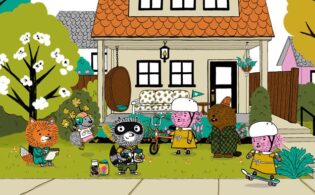Carl the Collector marks the first time a PBS KIDS show has been fronted by an autistic character. It follows as Carl the raccoon—who, as the title suggests, loves collecting things—interacts with the world and people around him, showcasing the ways in which those with autism may present.
Zachariah OHora had been writing and illustrating picture books for kids of all ages for a while and already had a character named The Collector who wore an Argyle sweater vest and enjoyed collecting trinkets when PBS came calling. The public broadcaster went looking for show creator possibilities outside its usual pool, and The Collector fit what it was seeking, OHora says.
As for the storyline itself, the seed of the idea was planted when OHora’s kids started to attend school and interact with different children. “We have a really good school system around here, and they have an inclusion system,” he explains. “That means that no matter what your needs are, you get the same amount of teacher time and socialization time with the other kids. [Even] if a kid needs to have an aide with them or whatever [else] they need, they get to be in the classroom; they’re not somewhere else.”
“It was a lightbulb moment for me when my oldest son, Oscar, just considered everybody a friend no matter what needs they had,” OHora continues. “It made me realize this is what the world needs. We need more normalization of the full spectrum of humanity. Take the stigma out of it and the mystery, and everyone will benefit from it. Obviously, neurodiverse kids are going to benefit from just being in a classroom, being a kid and making friends, and neurotypical kids are going to benefit from experiencing people who think differently. It’s a win-win for everybody.”
Yowza! Animation’s Lisa Whittick, director of the series, came on board when the show, produced by Fuzzytown Productions and Spiffy Pictures, was brought to the company for its animation services and she learned about the premise, which “means a lot to me personally,” she says. “My middle son is autistic, and a show like this when he was growing up would have changed a lot for him and it would have meant a lot to our family, would have relieved a lot of stress for us when he got diagnosed. We’ve all just been pouring our souls into this one. It’s a really, really special show.”
When the series had the full go-ahead, “right away, knowing that we wanted authentic representation—and that’s one of PBS’s focuses, too—we got autism advisers to draw up what these characters would look like and what their likes and dislikes might be,” OHora says. “Then we just tried to get as many neurodiverse people in all parts of the production.”
At its core, “it’s a show about self-identity,” he states. “These kids are just going to school. There’s a lot of stuff that is the same struggle for everybody: regulating your emotions, figuring out what your feelings are and learning who you are if you have a certain obstacle. That stuff is so universal.” It’s just that an autistic person may have a couple of extra steps trying to manage a given situation, he explains.
For Carl specifically, “one of the really charming things we do is we make sure he uses his collections a lot to interact with his friends and help solve problems,” Whittick says. “One thing that I can say from watching my own son grow up is he always had a special interest of his own. A lot of autistic people do have special interests, and he was always so excited to share whatever his special interest was. A lot of the time, my parents, for example, had no idea what he was talking about, but he was super thrilled to share. So, Carl is the same, where he has all of these special collections and no matter what the situation, he can somehow relate it back to one of his collections and help move the story along.”
She continues, “It is one of the few shows out there—if not the only one—that explicitly talks about autism and actually doesn’t shy away from any of the autistic traits that characters might have. We show stimming; we show meltdowns. We actually use the words ‘autistic’ and ‘meltdown’ in some episodes. We’re teaching kids the vocabulary around autism and what they mean.”
The Yowza! team came together to figure out a way to visually represent the way Carl and his friend Lotta, who also has autism, experience the world differently from neurotypical children. “We might go into [Carl’s] eyes and see what he’s seeing, and our compositing team and effects team will add distortions or blurs to the visuals around him,” Whittick explains. “And it’s not until he goes through some of the strategies that we teach in the show that he finally calms himself down and things go back to normal around him.”
For Lotta, who has completely different autistic traits than Carl, the visualizations differ. Lotta has synesthesia—a condition in which sensory information is processed through unrelated sensory pathways, such as seeing colors when hearing music. “Sometimes, the synesthesia is very enjoyable for her because she actually uses it to learn to play instruments,” Whittick says. “But other times, it can be overwhelming and can actually hurt her physically, like her ears. We did the exact same thing [we did with Carl], and we show the world from her point of view, what synesthesia may look like.”
The crew spoke with someone who experiences synesthesia the way Lotta does to accurately portray the way she sees the world. “We’ve definitely dug deep to try to figure out all the different ways we can tell the stories,” Whittick notes.
Each of the characters in the show is just as meticulously crafted as the rest and serves a purpose in furthering its message about diversity, inclusion and acceptance. “There’s all different things we can explore with the different characters,” OHora explains, pointing to Forest the Squirrel as an example. That character has ADHD and a nut allergy—something that is extra tough to navigate when you’re a squirrel and nuts are all your family eats.
“Another overarching theme is self-identity,” he adds. To address that theme, there are bunny twins that live near Carl who look identical. Other characters often confuse them for each other, which can be upsetting sometimes and funny other times. “Everybody is just trying to figure out at that age, Who am I? That’s a universal thing.”
Authentic representation on-screen could only be achieved by real representation behind the scenes. “Any character on-screen who is autistic is voiced by a person in real life who’s autistic, like Kai [Barham] and Maddy [McIlwain] as Carl and Lotta,” respectively, OHora says. “We talked to a couple of different groups to find people like Ava Rigelhaupt, one of the writers, who is amazing. She’s autistic, and she actually goes around and talks to people about inclusivity in entertainment, particularly about autism.”
Whittick notes that Yowza! didn’t need to make any changes or add any elements to its team to ensure this behind-the-scenes diversity. “I don’t think that the public is aware of how many neurodivergent people there are around us all the time,” she says. “I think that’s going to be something that the show will help people realize. People are different everywhere. We’re all different, and that’s OK, and that can be celebrated. We have [neurodivergent] crew members, artists and animators, and, of course, people like myself who have family who are autistic. We all work together to use our voices and figure out how best to portray that on-screen.”
The show appeals not just to children but to adults as well, making for a cross-generational co-viewing experience. “There are different levels of humor and references that are going on in the show,” says OHora, who has watched plenty of cartoons as a parent himself. “Carl’s parents, their names are Harold and Maude, which is like Harold and Maude, the Hal Ashby movie. There are a lot of things, little Easter eggs and stuff, that are for everybody.”
And it stands out because “there’s stimming and there’s pacing, and there are things that will differentiate these characters from your typical cartoon characters that you see on many other shows,” Whittick adds. “That part of it will be refreshing for the audience, and it will resonate across the world because neurodivergent people are everywhere.”
Ultimately, though, Carl the Collector is made up of “universal stories that are funny and fuzzy and a little weird,” OHora says.
 TVKIDS
TVKIDS






